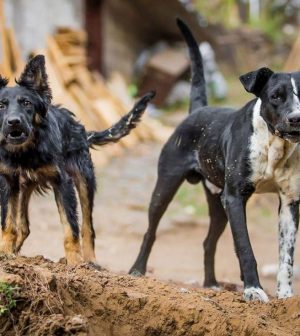- See What Saffron Can Do for Sleep and Heart Health
- 6 Common Mistakes to Avoid Before Your Physical
- Can Sweating Really Help You Beat a Cold?
- Strengthening Your Relationship: Practical Strategies
- Skip Storing This Everyday Product in the Fridge Door
- Green Tea + B3 Pairing May Boost Brain Health
- Navigating Your Midlife Crisis: Embracing New Possibilities
- City Raccoons Showing Signs of Domestication
- Mapping the Exposome: Science Broadens Focus to Environmental Disease Triggers
- One Week Less on Social Media Linked to Better Mental Health
Dog Bites More Common on Hot, Hazy Days

Just like their humans, dogs get cranky when temperatures and air pollution levels surge.
Heat and air pollution have previously been linked to human aggression. Now, researchers say it also appears that there are more dog bites on hot, polluted days.
More research is needed to confirm these findings, according to study author Tanujit Dey, of the department of surgery at the Center for Surgery and Public Health at Brigham and Women’s Hospital, in Boston, and colleagues.
For the new study, the investigators used dog bite data from 2009 to 2018 in eight U.S. cities: Dallas, Houston, Baltimore, Baton Rouge, Chicago, Louisville, Los Angeles and New York City.
The data included more than 69,000 reported dog bites, an average of three per day over 10 years.
When the researchers compared this bite information with daily levels of fine particulate matter (PM2.5), ozone, temperature, UV light and precipitation, they found that dog bites rose 11% on days with higher UV levels; 4% on higher temperature days; and 3% on days with increased ozone levels.
Dog bites decreased slightly, by 1%, on days with higher levels of rainfall. No changes were seen in dog bites on days with higher levels of PM2.5 air pollution.
The study findings were published online June 15 in Scientific Reports.
These records did not include information about other factors that could have affected an individual dog’s risk of biting. This can include breed, sex, and whether the dog had been neutered or spayed. The data also didn’t include information about prior interactions between the dog and the bite victim, the researchers pointed out in a journal news release.
Hot, polluted days have also been linked to increased aggression in Rhesus monkeys, rats and mice in past research, the study authors noted.
More information
The American Veterinary Medical Association has more on preventing dog bites.
SOURCE: Scientific Reports, news release, June 15, 2023
Source: HealthDay
Copyright © 2025 HealthDay. All rights reserved.










